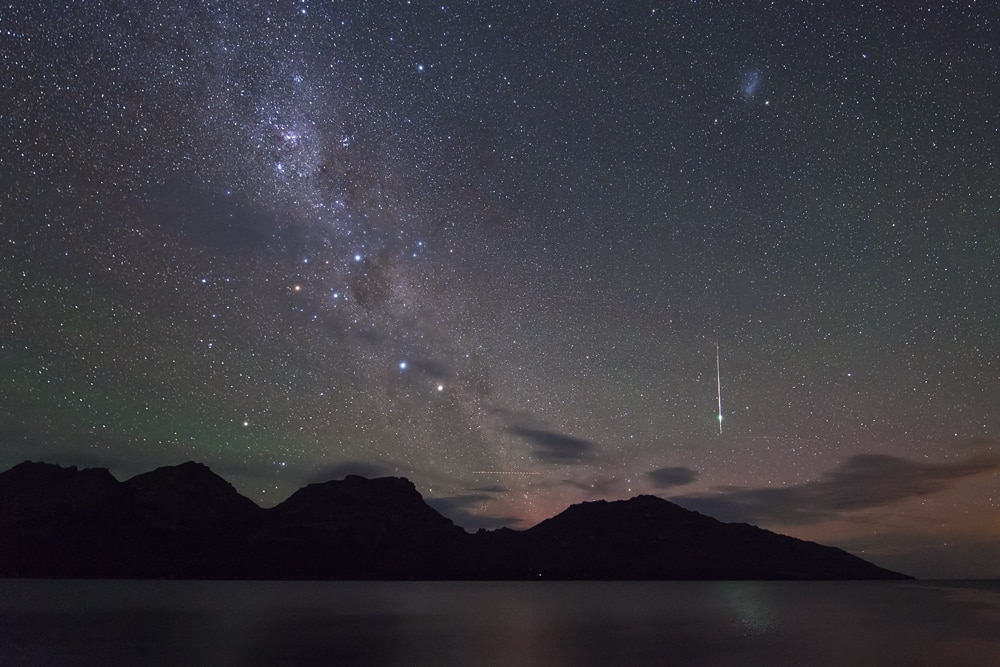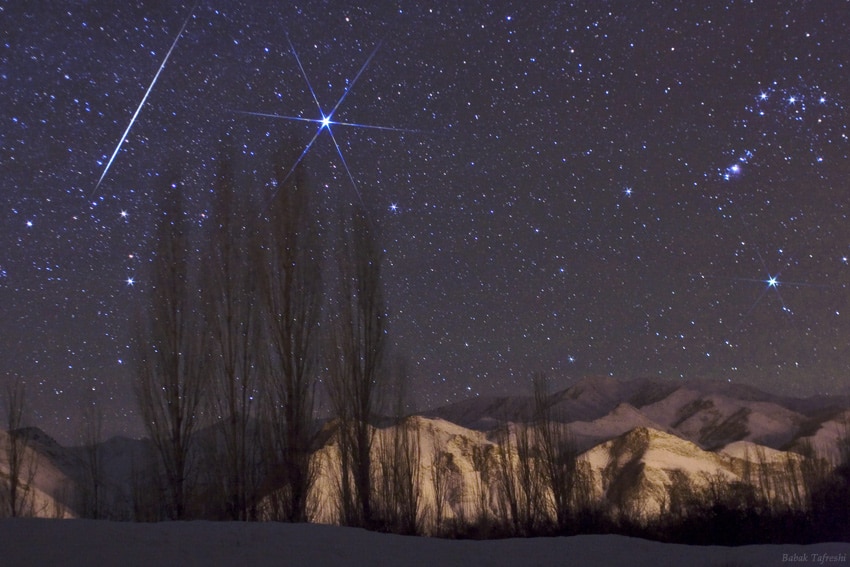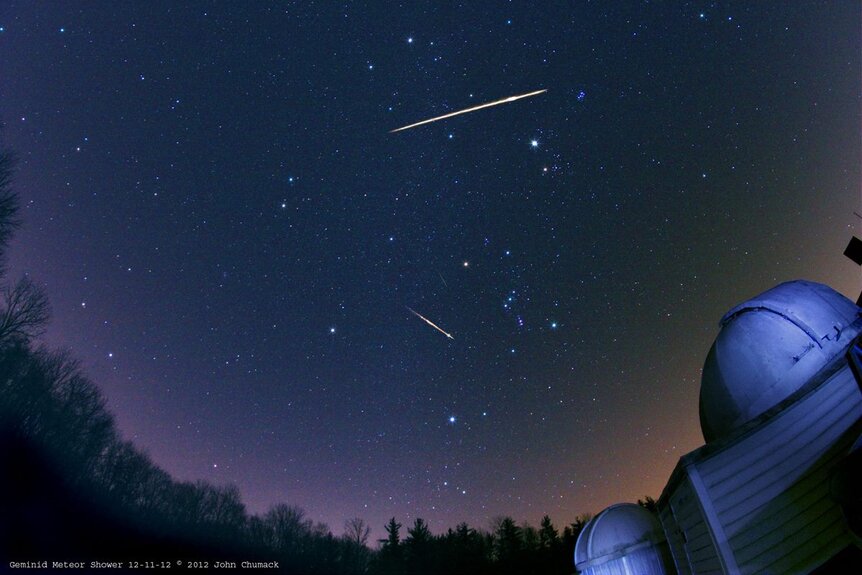Create a free profile to get unlimited access to exclusive videos, sweepstakes, and more!
The Geminids are coming! Here's how to watch one of the best meteor showers of the year.

[Note: This post is an updated 2020 version of the viewing guide I wrote for a previous Geminid shower.]
If you're looking for a way to see an amazing sight while simultaneously freezing your butt off, do I have the meteor shower for you: the Geminids!
This year (2020), the annual shower is best on the evening of December 13/14, Sunday night/Monday morning. In general, the viewing is best after midnight, though if you go out once the sky is fully dark Sunday evening you should see a few. Meteor showers can be hard to predict, but the Geminids is usually a good provider and sometimes a meteor a minute can be seen. Happily, the Moon is out of the way this year (it's very near the Sun in the sky and and a very thin crescent), so its bright light won't wash out the view! If you have clear skies, this meteor shower is really worth your time and effort to take a look.
Watching a shower is pretty easy; all you have to do is go outside, look up, and be patient. Shooting stars are somewhat random, so you might not see any for a few minutes, then you'll see three in a row. The longer you wait, the more you'll see.
But there are some things you should know. If you have clear, open skies, and follow the instructions below, you should have a celestial event to remember!
1) Time
Usually, meteors are best seen after local midnight (literally, halfway from sunset to sunrise), because that's when the Earth is facing into the oncoming meteors (like seeing more rain hitting your front windshield when you're driving in a storm). However, in this case, any time after about 10PM should work. The meteors appear to radiate away from a point in the sky in the constellation of Gemini (see No. 2), which is well above the horizon by then. The later you wait the better. I'll note that the actual predicted peak is 8:00 p.m. Eastern (US) time Sunday Dec. 13, but it's not like they suddenly peak and disappear! Anytime a few hours before or after that won't make much difference. So going out Sunday night once it's dark is fine. You could even go out the night before (i.e. tonight) or after, and there should still be a decent showing.
Once you're outside, it takes about 20 minutes for your eyes to get fully adapted to the dark—your pupils dilate, letting in more light, and your eye produces a light-sensitive protein called rhodopsin. Both of these take time to fully kick in. So don't be disappointed if you see very few or no meteors right away. White light will bleach the rhodopsin, by the way, so if you need some light, use a flashlight with red cellophane covering the front. That will preserve your night vision.
2) A Wide Open Sky
This is really important. Meteors appear in random spots on the sky and can go from horizon to horizon. The more sky you can see, the more meteors you'll see. Try to avoid nearby buildings, trees, and so on.
If you trace the path of the meteors backward, they will appear to radiate from one point in the sky located in the constellation Gemini (hence the shower name). This is the same effect as when you're driving a car through a tunnel and the lights on the walls and ceiling appear to come from the point ahead of you. A good view of Gemini will up the odds of seeing more meteors. If you can find Orion, Gemini is to its upper left (for folks in the Northern Hemisphere; in the Southern Hemisphere this shower isn't nearly as prolific because Gemini is much lower in the sky).
No matter what, a big wide view is your best bet.
3) Dark Skies
Meteors are generally not terribly bright. A few can be blazing, but most are about as bright as your average star, so you want to be away from lights. Your backyard might be fine, but make sure street lights are blocked and your house lights are off.
4) A Lounge Chair
You need to be able to see a lot of the sky for minutes or hours, so you want to be comfortable. A chaise lounge or a folding beach recliner is a big plus. You can lie on the ground with a blanket if you want, but comfort is important if you're going to be out for a while. The ground tends to be cold at night, and wet too. Which reminds me ...
5) Blankets!
Hello, it's December, and that means it'll be cold. You won't be moving much, either, so you won't be generating much heat. You won't see many meteors if your teeth are chattering (I imagine hypothermia won't help either). Stay warm!
6) Telescope, Binoculars
I recommend not using a telescope. Why not? Telescopes see only a small part of the sky, and meteors appear in random spots. I guarantee the best meteor of the night will happen while you are stooped over an eyepiece, and you'll miss it.
Binoculars are better. You can scan the sky, look for interesting things, and still be able to look around quickly if a bright meteor appears.
7) Star Chart
Hey, you're outside! Why not get familiar with the sky? You can find charts at local bookstores and online if you do a little searching. Orion, Gemini, Taurus, the Pleiades ... this is a fine time of year to be out looking for cosmic landmarks.
8) Rest
Oh boy, is this one important. It's after midnight, you're lying down, snuggled in a blanket, it's dark, and your eyes are focused on infinity. You start daydreaming a bit ... and the next thing you know, the Sun is rising and you're covered in frostbite.
Take a nap in the afternoon if you want. I give you permission.
9) Friends, Family, Neighbors
Having other folks with you will help you stay awake, and honestly, the joy and beauty of a meteor shower is best shared. One of my favorite times ever with my daughter was watching the Leonids meteor shower when she was little. She had a blast, and not just because she got to stay up until 3AM with her dad ... but then again, that's a big part of it, too.
10) An Appreciation of What You Are Seeing
Read up on meteor showers, what they are, what we've learned from them. The Geminids are debris from an asteroid called 3200 Phaethon, which sometimes acts a bit like a comet (every other shower comes from debris sloughed off by comets). Asteroids orbit the Sun for billions of years, and you're seeing tiny parts of them—most no bigger than a grain of sand—as they slam into our atmosphere a hundred kilometers above you at speeds of up to 40 kilometers per second. How cool is that? I think it's fun to know more about an event, especially one in which you're participating.
Bonus) Wonder
This may be the best thing to bring, and the easiest. Meteor showers are simply wonderful. It's a cosmic show, and it's free, and it's very, very cool.
Enjoy it!




























